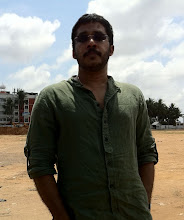 After quite a wait, I could finally get to watch one of my favourite actors, Forest Whitaker as Idi Amin, the earstwhile dictator of Uganda, in "The Last King of Scotland". I was really curious about the title: what is the connection between Uganada and Scotland and that too a "King" from "Scotland"?
After quite a wait, I could finally get to watch one of my favourite actors, Forest Whitaker as Idi Amin, the earstwhile dictator of Uganda, in "The Last King of Scotland". I was really curious about the title: what is the connection between Uganada and Scotland and that too a "King" from "Scotland"?
In this movie, Forest Whitaker is brilliant and is true to the tagline: charming, magnetic, murderous. His arresting performance, replete with subtle nuances in mannersims, idiosyncrasies and the intelligent use of his hulking frame to recreate a real character, who has been featured on celluloid many times earlier, is the highlight of this straightforward film. The story is about Idi Amin's notorious regime in Uganda in the 70s, woven around the strange relationship between him and his Scottish physician Nicholas Garrigan, played by James McAvoy, the young Scottish actor whom we saw last in the "Chronicles of Narnia". James had done a brilliant job too bringing to screen a heady mix of boyish exuberance, sexual adventure (he ends up having sex with one of the wives of Idi Amin), compassion and the fear of a dreaded despot. The only other known face in this film is X-filer Gillian Anderson, who plays the insignifcant role of a fellow doctor. For a change, she looks haggard and fragile.
The film is well written and has a style that evokes curiosity, emotional engagement and fear. The grammar seemed appropriate: wide angle lenses which the characters dramatically walk into at the right situations; handheld shots for scenes that are tense and fearful, unsteady shots when things really go out of control; intelligent use of sound and cuts that are surgically precise.
The background elements that are elaborately and carefully reconstructed with the detailed properties, costumes and people, are not excessively brought upfront - the subtle nuanced style of context-setting. A huge of amount of painstaking details fill the background so that the settings and situations look authentic.
The film also symobolises the new style of film making: films that have a casual elegance about them and films, though richly detailed, that don't make a fuss about being detailed. One can sense a carefully calibrated colour scheme and good use of DI; unconventional shooting schemes that involve hundreds of people filling the scenes, and a large number of vividly detailed characters. Personally, I felt the shooting style was similar to that of The Constant Gardener, directed my current favourite Fernando Meirelles. This Brazilian director, who surprised the world with his "City of God", has devised a style that moves away from the "start-action-cut" routine and uses minimal paraphernalia so that film-making can unobtrusively move to real settings capturing exciting subtexts and unpredictable texture. Many directors now creatively use the intrigue that a slightly shaky handheld can create (by the way the hand held shots in the Indian movie, "Guru" were painful and pretentious). Remember those shaky action shots in "Bourne Identity"?
The "Last King of Scotland" is also about Africa and how native pride is grossly exploited by megalomaniac, blood thirsty despots.
Africa and Africans are increasingly becoming a mainstream Hollywood theme and the production houses are making money too. In the recent past we saw "Black Hawk...", 'Hotel Rwanda" and "Shotting the Dogs" followed by "Constant Gardener" "Blood Diamond"and "Catch a Fire". Perhaps Africa, its ragged and exotic looks, despots, violence, AK-47s, gore, genocide, poverty-stricken people and a few white characters make a good box office mix.
(Disclaimer: I am not too sure if the story is fictitious or real. The film claims to have been inspired by real characters and real incidents. However, in a report in The Herald Tribune on the premiere of the film in Kampala, I have read that the relationship between Amin and Nicholas is fictitious. Perhaps somebody can clarify)





